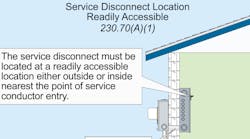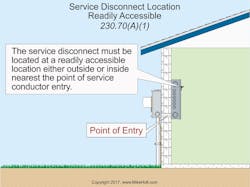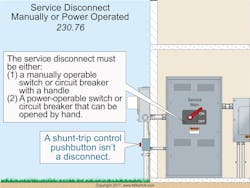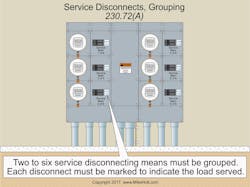In Part 1 of this two-part series, we addressed the general requirements for services. In Part 2, we’ll address the requirements for the disconnecting means (Art. 230, Part VI) and the overcurrent protection (Art. 230, Part VII) of services.
While these requirements are not particularly difficult to follow, they are often violated. In many cases, the requirements were met with the initial installation but later violated because of some modification. Usually, such modifications are in response to equipment changes as the facility adjusts to changing needs. Thus, this article applies to both existing and new services.
Service Disconnects
The service disconnect must open all service-entrance conductors from the building premises wiring [Sec. 230.70]. Where you put it matters because it’s the means by which first responders de-energize the power infrastructure. You don’t want firefighters trying to figure out where you hid the disconnect, you want them to find it right away. So for every building, that switch is in a readily-accessible location nearest the point where the service conductors enter (either outside the building or inside it) [Sec. 230.70(A)(1)] (Fig. 1).
You don’t want first responders checking the bathroom for the service disconnect. Aside from the proximity to water, that location would not be readily accessible, nor would it be nearest the conductor entry point. In addition, the NEC explicitly prohibits this [Sec. 230.70(A)(2)].
Since service-entrance conductors don’t have short-circuit or ground-fault protection, they must be limited in length when installed inside a building. Some jurisdictions specify a maximum length within a building.
If a remote-control device (such as a push-button for a shunt-trip breaker) actuates the service disconnect, then that disconnect must be in a readily-accessible location nearest the service conductor entry point (either outside the building or inside it) or as required by Sec. 230.70(A)(1) [230.70(A)(3)].
The service disconnect must:
• Consist of a manually operated switch, a power-operated switch, or a circuit breaker that’s also capable of being operated manually [Sec. 230.76].
• Be permanently marked to identify it as part of the service disconnecting means [Sec. 230.70(B)].
• Be suitable for the prevailing conditions [Sec. 230.70(C)].
You can’t have more than six service disconnects for each service permitted by Sec. 230.2, or for each set of service-entrance conductors permitted by Sec. 230.40, Exceptions 1, 3, 4, or 5 [Sec. 230.71(A)]. The reason is the same reason that each disconnect must be readily accessible and close to the entrance: time. First responders have only so much time, especially in the crisis that originally brought them to the site.
The service disconnecting means can consist of up to six switches or circuit breakers mounted in a single enclosure, in a group of separate enclosures, in or on a switchboard, or in switchgear. The rule is six disconnecting means for each service, not for each building. If the building has two services, there can be a total of 12 service disconnects (six per service).
Note also that a PV disconnect on the supply side of service equipment isn’t a service disconnect. Don’t count this when you’re determining the number of service disconnects [Sec. 230.82(6)]. Furthermore, disconnecting means used for the only following aren’t considered service disconnects [Sec. 230.71(A)]:
(1) Power monitoring equipment.
(2) Surge protective device(s).
(3) Control circuit of the ground-fault protection system.
(4) Power-operable service disconnect.
Grouping
When installing the disconnects for a given service, group them [Sec. 230.72(A)] (Fig. 2). This way, when first responders find one, they’ve found them all. There is no need to spend time searching.
However, you don’t want to lose the power to your fire pumps [Art. 695], emergency systems [Art. 700], legally required standby systems [Art. 701], or optional standby systems [Art. 702]. So for this equipment, you must locate the disconnect(s) remote from the disconnects for normal service [Sec. 230.72(B)]. Because emergency systems are just as important as fire pumps and standby systems, ensure they have the same safety precautions to prevent unintended interruption of power.
Occupant Access
In a multiple-occupancy building, each occupant must have access to their service disconnect [Sec. 230.72(C)]. In multiple-occupancy buildings where electrical maintenance is provided by continuous building management, however, you can make the service disconnecting means accessible only to building management personnel.
Some Disconnect Requirements
The service disconnect must indicate whether it’s in the OFF (open) or ON (closed) position [Sec. 230.77]. And it can consist of [Sec. 230.76]:
(1) A manually operable switch or circuit breaker equipped with a handle or other suitable operating means.
(2) A power-operated switch or circuit breaker, if it can be opened by hand in the event of a power supply failure. (Fig. 3).
The disconnecting means rating must be at least that of the calculated load per Art. 220, and in no case less than [Sec. 230.79]:
(A) One-circuit installation. For installations consisting of a single branch circuit, the disconnect must have a rating of at least 15A.
(B) Two-circuit installation. For installations consisting of two 2-wire branch circuits, the disconnect must have a rating of at least 30A.
(C) One-family dwelling. For a one-family dwelling, the disconnect must have a rating of at least 100A, 3-wire.
(D) Other installations. For all other installations, the disconnect must have a rating of at least 60A.
Note that a shunt-trip button doesn’t qualify as a service disconnecting means because it doesn’t meet any of the above requirements.
Connections
When connecting the service conductors to the service disconnecting means, you must use pressure connectors, clamps, or other means approved by the authority having jurisdiction. You cannot use solder to make these connections [Sec. 230.81].
Supply Side Disconnect Connections
Only the nine types of electrical equipment listed in Sec. 230.82(1) through (9) can be connected to the supply side of the service disconnecting means. That’s equipment such as meter sockets and instrument transformers rather than utilization equipment. Also, some electric utilities require a disconnect switch ahead of the meter enclosure for 277/480V services to enhance safety for electric utility personnel.
A couple of other notable exceptions from the list:
• Type 1 surge protective devices can be connected to the supply side of the service disconnect enclosure. A Type 1 surge protective device is listed to be permanently connected on the line side of service equipment [Sec. 285.23].
• Taps used to supply legally required and optional standby power systems, fire pump equipment, fire and sprinkler alarms, and load (energy) management devices can be connected to the supply side of the service disconnect enclosure.
A couple of items that do not appear on the list:
• Emergency standby power; don’t supply this equipment by a connection ahead of service equipment [Sec. 700.12].
• Transfer switches for generators, unless they’re rated as the service disconnect per Sec. 230.66.
Service Equipment Overcurrent Protection
Each ungrounded service conductor must have overload protection [Sec. 240.21(D)]. The NEC doesn’t require service conductors to have short-circuit or ground-fault protection, but the feeder overcurrent protection device provides overload protection for the service conductors.
The rating of the overcurrent protection device cannot be more than the ampacity of the conductors [Sec. 230.90(A)]. However there are several exceptions, such as:
Exception No. 2: If the ampacity of the ungrounded conductors doesn’t correspond with the standard rating of overcurrent protection devices as listed in Sec. 240.6(A), then the next higher overcurrent protection device can be used if it doesn’t exceed 800A [Sec. 240.4(B)].
Exception No. 3: The combined ratings of two to six service disconnecting means can exceed the ampacity of the service conductors if the calculated load (per Art. 220) doesn’t exceed the ampacity of the service conductors.
Exception No. 5: Overload protection for 120/240V, 3-wire, single-phase dwelling unit service conductors can be per Sec. 310.15(B)(7).
Location
Where circuit breakers are used for service overcurrent protection, they must be integral with, or immediately adjacent to, the service disconnecting means [Sec. 230.91].
Ground Fault Protection
Ground-fault protection of equipment is required for 277/480V service disconnects rated 1,000A or more. The rating of the service disconnect is based on the rating of the largest fuse that can be installed or the circuit breaker’s highest continuous current trip setting (Sec. 230.95).
Beyond the NEC
Because the NEC provides the minimum requirements for the protection of people and property [Sec. 90.1], conforming to its requirements for services is only part of doing a good job with a service installation.
Several related industry standards exist, as do industry best practices. Things such as commissioning a breaker coordination study and providing excellent lighting for switchgear maintenance are well worth the investment. Also, consider specifying infrared windows when specifying the service panels — an investment that hugely slashes maintenance costs.
Also, always perform baseline testing of the service equipment and conductors. This is one of the most cost-effective measures that can be taken with a new installation. It can be very costly to “save money” by skipping it.
These materials are provided to us by Mike Holt Enterprises of Leesburg, Fla. To view additional Code training materials offered by this company, visit www.mikeholt.com.







